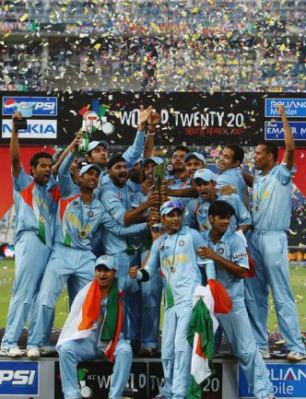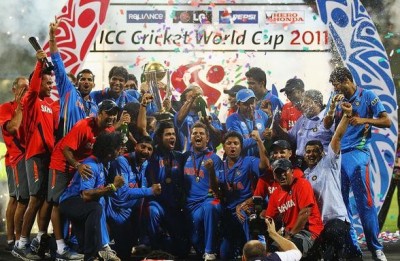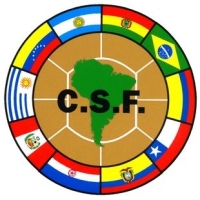From "The Indian cricket team" to "Team India" !!
18 AprThe basics of football – Part 2 – FIFA and The FIFA world-cup
21 Jan |
| FIFA Confederations |
AFC – Asian Football Confederation in Asia and Australia with headquarters in Bukit Jalil, Kuala Lumpur, Malaysia and has 46 member countries
CAF – Confédération Africaine de Football in Africa with headquarters in 6 October City near Cairo, Egypt and has 53 full members
CONCACAF – Confederation of North, Central American and Caribbean Association Football in North America and Central America with headquarters in New York City, United States and has 40 full members
CONMEBOL – Confederación Sudamericana de Fútbol in South America with headquarters in Luque, Paraguay and has 10 full members
OFC – Oceania Football Confederation in Oceania with headquarters in Auckland, New Zealand and has 11 full members
UEFA – L’Union Européenne de Football Association in Europe with headquarters in Nyon, Switzerland and has 53 full members
- Africa – 5
- Asia – 3.5
- Oceania – 0.5
- Europe – 13
- North and Central America and Caribbean – 3.5
- South America – 4.5
0.5 indicates 1 team gets selected through an intercontinental playoff.
1 berth for the winners of CONMEBOL-CONCACAF playoff and
1 berth for the winners of AFC-OFC playoff
Qualification in all zones ends during the September–November months of the year before the finals.
2018 – Russia and
2022 – Qatar
 |
| Julius Rimet Trophy |
- The Preliminary or the group stage
- The knock out stage
|
Year
|
Host Country
|
Winner
|
Score
|
|
1930
|
Uruguay
|
Uruguay
|
Uruguay 4-2 Argentina
|
|
1934
|
Italy
|
Italy
|
Italy 2-1 Czechoslovakia
|
|
1938
|
France
|
Italy
|
Italy 4-2 Hungary
|
|
1942
|
not held due to WW2
|
||
|
1946
|
not held due to WW2
|
||
|
1950
|
Brazil
|
Uruguay
|
Uruguay 2-1 Brazil
|
|
1954
|
Switzerland
|
Germany
|
Germany 3-2 Hungary
|
|
1958
|
Sweden
|
Brazil
|
Brazil 5-2 Sweden
|
|
1962
|
Chile
|
Brazil
|
Brazil 3-1 Czechoslovakia
|
|
1966
|
England
|
England
|
England 4-2 Germany
|
|
1970
|
Mexico
|
Brazil
|
Brazil 4-1 Italy
|
|
1974
|
Germany
|
Germany
|
Germany 2-1 Holland
|
|
1978
|
Argentina
|
Argentina
|
Argentina 3-1 Holland
|
|
1982
|
Spain
|
Italy
|
Italy 3-1 Germany
|
|
1986
|
Mexico
|
Argentina
|
Argentina 3-2 Germany
|
|
1990
|
Italy
|
Germany
|
Germany 1-0 Argentina
|
|
1994
|
US
|
Brazil
|
Brazil 3-2 Italy
|
|
1998
|
France
|
France
|
France 3-0 Brazil
|
|
2002
|
Japan / S. Korea
|
Brazil
|
Brazil 2-0 Germany
|
|
2006
|
Germany
|
Italy
|
Italy 1-1 (5-3) France
|
|
2010
|
South Africa
|
Spain
|
Spain 1-0 Netherlands
|
- Golden Ball for the best player with a shortlist drawn up by the FIFA technical committee and the winner voted for by representatives of the media.
- Golden Boot for top goal scorer. In case of 2 players holding the top position, the tie-breaker goes to the player who has contributed the most assists. If there is still more than one player, the it goes to the player who has played the least amount of time.
- Golden Glove Award for best goalkeeper
- Best Young Player award for best player at-most 21 years of age and voted in the official FIFA website.
- FIFA Fair Play Trophy for the team with the best record of fair play based on least fouls (yellow and red cards)
- Most Entertaining Team award for the team that has entertained the public the most during the world cup with the winners being selected by public voting.
- An All-Star Team comprising the best players of the tournament chosen by FIFA’s technical study group, and since 2010 by an online poll on the FIFA.com.
save
The basics of Football
14 Sep |
| Football pitch |
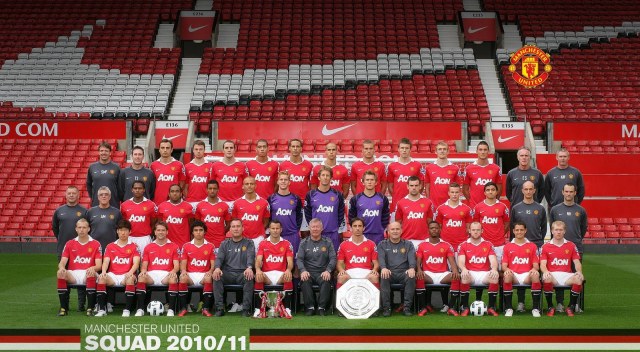 |
| Manchester United squad of 2010-11 and its officials |
- Planning the strategy of every match.
- Formation of the team and style of play including the positions.
- Selecting a players lineup for matches including the substitutes.
- Passing on instructions to the players during the game.
- Delegating the duties to first team coach and the coaching and medical staff.
- Buying and selling players in the transfer market, including loaning of players to other clubs.
- Scouting for young and talented players for eventual training in the youth academy or the reserves team.
“Diagonal system of control” is a system where the referee and the lines-man (or assistant referees) split the footballing pitch into the quarters as shown below for controlling the game.
 |
| Diagonal system of control |
- Unsporting behaviour
- Dissent by word or action
- Persistently infringing the laws of the game
- Delaying the restart of play
- Failing to respect the required distance of a corner kick or free kick
- Entering or re-entering the field of play without the referee’s permission
- Deliberately leaving the field of play without the referee’s permission
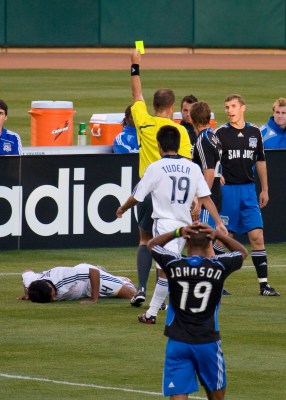 |
| Yellow card |
Red card indicates a send-off which means the player cannot participate in the match any longer and the affected team plays one player short. There are two ways a player can receive a red card which are direct and indirect red. A Direct red results in disqualification of the offending player for one or more of subsequent matches. The number of matches for which he is suspended depends on the offense committed and by a committee that looks into the issue. An Indirect red is obtained when a player receives two successive yellow cards in a game. The seven reasons for a send-off are:
- Serious foul play (a violent foul)
- Violent conduct (any other act of violence)
- Spitting at anyone
- A deliberate handling offense, to deny an obvious goal-scoring opportunity, by any player other than a goalkeeper in his own penalty area
- Committing an offense that denies an opponent an obvious goal-scoring opportunity (informally known as a professional foul)
- Using offensive, insulting or abusive language or gestures
- Receiving a second caution (yellow card) in one game.
- Touching the ball a second time following a restart
- The keeper touching the ball with his hands when a teammate has used his foot to pass it back to the keeper
- Offside
- When play is stopped to caution or send-off a player when no specific foul has occurred such as for dissent.
 |
| Indirect free kick |
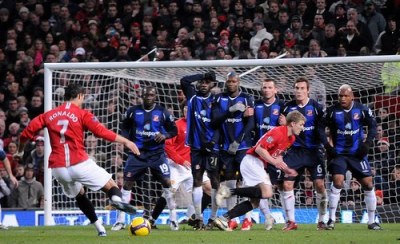 |
| Direct free kick with a wall of 6 players |
 |
| Penalty kick |
 |
| Corner kick |
 |
| 2 players with the blue jersey are outside the last defender when the pass is made. Hence Offside |
- All kicks are taken in one end of the pitch.
- A toss decides who takes the penalty first.
- Teams take penalty kicks alternatively for a count of 5 kicks.
- No player can take the kick twice until all eligible players in the team have taken the kick at-least once.
- If a ball is saved or missed then it cannot be re-kicked in.
- At the end of five kicks if the score line is still deadlocked then we move to “Sudden death” where in a single kick from both sides is taken to decide which team won the game.
 |
| Penalty shoot-out |
IPL 4 player retention prediction
7 SepWith the IPL4 auctions starting in November, I will put-in my list of players, who will be retained by the clubs. The new rule suggests that, each of the initial 8 IPL teams, can retain 4 of their existing players, which includes 3 Indians and 1 foreigner. The list was made upon my belief that, each of these players, are almost guaranteed to have a starting place, in any of the IPL teams. Here is the list:
Royal Challengers Bangalore
- Praveen Kumar
- Robin Uthappa or Virat Kohli
- Anil Kumble
- Ross Taylor or Jaques Kallis
Mumbai Indians
- Sachin Tendulkar
- Zaheer Khan
- Harbhajan Singh
- Lasith Malinga or Kieron Pollard
Chennai Super Kings
- Mahender Singh Dhoni
- Suresh Raina
- R Ashwin
- Albie Morkel or Michael Hussey
Deccan Chargers
- Pragyan Ojha
- Rohit Sharma
- RP Singh
- Adam Gilchrist
Delhi Daredevils
- Goutam Gambhir
- Virender Sehwag
- Ashish Nehra
- Dirk Nannes
Kings XI Punjab
- Irfan Pathan
- Yuvraj Singh
- PP Chawla
- Kumar Sangakkara or Mahela Jayawardene
Rajasthan Royals
- Yousuf Pathan
- Munaf Patel
- SK Trivedi
- Shane Watson or Shane warne
Kolkata Knight Riders
- Sourav Ganguly
- Murali Kartik
- Ishant Sharma
- Chris Gayle or Brendon McCullum
There are some players who are too good to be ignored. In those cases, I have added them in the “or” option. Come this November, let us see what percentage of players I have got correctly…. 🙂
Will we, wont we?? The 2010 CWG – India’s pride at stake
6 SepCome 3 October, 2010, India is “supposed!!” to host the Opening ceremony of the quadrennial event, The Commonwealth Games (CWG). This is the first big event to be held the India since the 1982 Asian games. With exactly 4 weeks to go before the start of the Commonwealth games 2010, let us check the overview of the games.
The 19 venues for the games are as below:
* Jawaharlal Nehru Stadium, Delhi – Athletics, lawn bowls and weightlifting also hosts the Opening and Closing ceremonies.
* Dhyan Chand National Stadium – Hockey
* Indira Gandhi Arena – Archery, cycling, gymnastics, wrestling
* Delhi University sports complex – Rugby sevens
* Thyagaraj Stadium – Netball
* Siri Fort Sports Complex – Badminton, Squash
* Dr. Karni Singh Shooting Range – Shooting
* Talkatora Stadium – Boxing
* SPM Swimming Pool Complex – Aquatics
* RK Khanna Tennis Complex – Tennis
* Yamuna Sports Complex – Table tennis
 |
| Jawaharlal Nehru Stadium |
* 14 blocks, 34 residential towers having 1168 AC apartments with 4008 bedrooms for the guests.
* The Main Dining Hall with a seating capacity of 2300, capable of serving 22000 meals daily.
* A Polyclinic to provide Medical services.
* Fitness center, Bank, post office, general store and a hair salon.
* Prayer rooms for all faiths.
* Facilities for athletes to train for athletics, aquatics, weightlifting and wrestling.
“Jiyo Utho Badho Jeeto” – The official song composed by A R Rahman.
Trouble before the games:
Our motto during the bidding of the CWG was “New Frontiers and Friendships”. What we meant by New frontier was, stooping so low at organizing these games, that new frontiers of in-capabilities and corruption were faced at all levels possible. Manishanker Aiyer, the former Minister of Youth and Sports Affairs, was one of the first to talk rather be a whistle blower, about the delay in the preparation for the games. He said that he would be “unhappy” if the Games were a success and wished for the “Commonwealth games to be spoiled.” and hoped “the expenses could have been utilized for ensuring a better sporting future for Indian children by providing them sports training”. Now, this could as well be a political tactic. But there is some truth in that. Once a hole was made in the wall, however small it was, the rats or rather the media were waiting to grab the opportunity for increasing their TRP ratings for the next one month, went in and took the place apart. Thus came story after story of inefficiencies and troubles which the Organizing Committee face even at the present moment and hopefully will not for the next whole month once the games begin.
1) Corruption allegation – Works awarded to ineligible agencies. Higher prices awarded for works. Items incurred for rent at a cost much higher than what it would have cost to purchase them. Poor quality of work.
2) Half built Stadiums – 13 of the 19 venues behind the final schedule of August 31.
Venue safety at Jawaharlal Nehru stadium, or any other stadium, where the CVC (Central Vigilance Commission) report suggested use of sub-standard materials and fabricated case results. Safety certifications undelivered on other completed stadiums.
3) Damage in the track itself due to heavy rains – needs to be rectified by the IAAF.
The Scoring systems not ready – TSR (Thomas Scoring and Results) equipment which are the actual Scoring systems during the games are unready. TRS is the technology responsible for storing data and recording timings. Now add the cameras and communications to that list. Thankfully, the deadline for this is October 3.
4) Games village unready – For Instance, Catering is not yet ready for Sept 16, when the officials around 300 to 400 members from various countries arrive, which is just 10 days away.
5) Is the security in the stadium compromised because of the delay?
The home ministry revealed that the security agencies will not have access to the stadiums till September 8, which implies they have only one week to install the systems required for monitoring and securing the Games against the actual request of 4 weeks. Now the security agency has to work 4 times faster which implies forget sleep for the next 45 days.
6) Rains creating havoc with roads – reports of roads caving-in found all over the news papers.
7) Delhi traffic – can the athletes reach the venues on time? Solution suggested is for a dedicated lane for the games and free metro & bus transport for people with games tickets. This is a good idea. But will the people of Delhi for once, show some common sense and follow that??
8) 1221 Dengue cases this year which is the highest in last five years and against a handful last year. What if the athletes are hit??
9) “Jiyo Utho Badho Jeeto” – The official song composed by A R Rahman ran into trouble with politicians and games organizers combining to condemn the song, for lacking enthusiasm and not appealing to the global audience, like the super-hit “waka waka” of Shakira fame for the FIFA world cup. Rahman seems to be reworking on that. I wonder what the committee were doing, till Rahman went public about the song. Couldn’t they have had a preview of that and asked him to change before he went public. Surely, stupidity levels are reaching sky limit.
Now how can we add some salt to the wound and readily the athletes put their hands up to be counted and add more shame:
10) Doping shame –
4 wrestlers, shot-putter in CWG squad fail dope test.
Three swimmers, including two in CWG team fail dope test.
11) Big star athletes pulling out of the event citing various reasons. To name a few:
* Usain Bolt. for people who haven’t heard of him – World and Olympic record holder in the 100m, the 200m & 4x100m relay.
* Mo Farah of England – Two-time European champion long distance runner.
* David Rudisha of Kenya – 800m world record holder.
* Shelly-Ann Fraser of Jamaica – 100m reigning Olympic champion and World champion.
* Chris Hoy of Britain – multiple world champion and Olympic Games gold medal winner.
12) Terror threat to the games – Whenever there is a mega event, these are quite common. But with Maoists joining the band to say: “Why should only jihadis scare our people, we should do it too”, the alarms for another “Munich” have been ringing for quite some time.
These games are not about winning or losing medals. It is about showing your culture to the rest of the world. And I believe, we have lost out on a big opportunity in this front with these huge glitches or rather potholes in the planning and execution. But with this atleast, there are some positives. The athletes at the national level have atleast a good stadium to win a few medals in Asian and the next CWG if not the Olympics. The people of Delhi have a good new airport terminal, better roads and amenities such a excess power than what was present before the games.
Now comes the big question. Will we, wont we host good games???
The love of my life… :)
21 Jul
My first love was Cricket and the first match I saw was the 1992 worldcup finals between Eng and Pak..
I dont know the reason for this; it could be media attention or the sheer class of the player I loved Sachin’s style of play from the moment i saw him play.. Right from his exploits in Pak as a 16 year old to the ongoing Srilankan tour I never felt more in awe of any cricketer more than Sachin.. Some people might call me naive.. maybe thats what I am.. i say this to them: A player who has given his best for 20 years at the highest possible level and still does is a true champ. Is he the best in business is a discussion and fight that can go on for the next few generations. But to me the hero who was the light at the end of the tunnel when world cricket was rocked by fixing allegations. Imagine the situation if Sachin was dragged into it. That would have been the end of Cricket in India for sure. There are a number of different statistics which can be put up to say he is one of the best. But why bother? There are too many shows, sites and blogs already doing that. The biggest dream for many true Indian fans would be for Sachin to hold aloft the worldcup at the Wankhede on 2nd April, 2011.
What is sports if we dont have speed.. Formula 1 and Motogp fulfills the criteria. Ferrari and now Force India draw my prayers and hopes. I am proud that a team with an Indian owner is present in F1 – the pinnacle of Motorsports. There will soon be a day when the Indian anthem is sung at the constructors/drivers presentation ceremony of a Grandprix. In motogp we have Japanese bikes ruling the roost. The thing which the F1 lacks is in the number of overtaking manouvers. Though the research that goes into Motogp is nowhere comparable to F1, the former wins peoples heart as almost half of the pack have the machines required to win the race. It purely comes down to the drivers individual skill and the ability to sustain pressure for long duration.
Now to the American sports. Not that they were born in America but the fact these games at the highest possible levels here gives me the license to call them American. Basketball, Baseball, American football you name it; they are the best in business. The Celtics vs Lakers rivalry is big as it gets. Michael Jordan has been my all time favorite. His Nike jump image promoting the “Air Jordan” brand has been the wallpaper in my phone for as long as i remember.. 😀 Lebron James has talent but like Sachin not able to achieve much in a team. But Kobe like Ricky Ponting in cricket has the luxury of a better team in Lakers.
If there is one sport which is sheer class is tennis. Roger I consider the best in the current generation. 16 titles at the age of 28 shows what a player he has been.
Now I have saved the sport that has been my favorite to the last.
Football – the beautiful game: Defined as a game that can take your breath away, raise individuals to position of demi-gods or bring them down to earth and drag them to a shell. This amazing game has been my favorite, overtaking even cricket, which in my school days wouldn’t have believed that it would happen. The agility of the EPL, the beauty of La Liga, the grit of Bundesliga and the drama of Serie A is just addictive. I am sorry to not have added any other leagues as the telecasting in India is limited to only these. Even with these restrictions my weekends are left unfulfilled without a few of the beautiful games. Manchester United and Barcelona have been my favorite clubs since I started watching the sport. The tension, the passing, the pain, the joy, the exhaustion felt by the players are as if experienced by me.
It is a well known fact that the South Americans produce the best footballers in the world. But then again football is not just about goals. It is also about tactics and strategies.Here is where the Europeans score. The amount of background work that goes into a football match is too big. Every players movement, passes to, takes passes from, goals scored from the list goes on.. everything is watched recorded. Then they are provided on the plate for the coach who is the orchestrator. The players are just the actors in this huge setup. unlike other sports the coach and his staff have a big say in the outcome of a match. That’s the reason we can see so many big teams lose matches against team little known of or teams whose skills are much lower. People consider the 2010 finals as boring. But I loved it. Let me give a simple example of why so: Robben plays on the right for the Dutch and during the entire match for the sole reason of blocking Robben’s run we had Capdevilla who never over ran him and supported Villa on the left. This caused all the Spanish attack to come from the right. A simple tactical move of not allowing a defender to not do over-lapping runs allowed the Spanish to successfully block the biggest danger to them but at the cost of not allowing David Villa their best player in the tournament to sit idle for an entire match. Result Spain win thanks to Andre Iniesta who had no such marking like Robben had on the Spanish right.
I know some people have better knowledge than me in most of these sports. But I love sports in general too much to bother about the comments..:)




